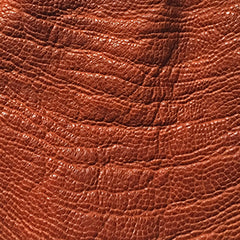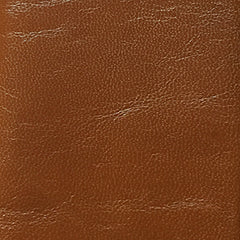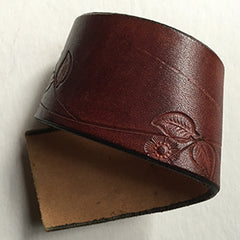
A field guide to leather: glossary of terms
Share
Several years ago a customer of mine brought her entire class of second grade students to my shop to learn about leather and how shoes are made and repaired. My assistant and I were a bit concerned that some of the students might become “emotional” when they found out where leather actually comes from. I began my presentation by asking the kids if they’d ever seen leather and if they knew where it comes from. It turned out that not a single student knew where leather came from. Some brave students guessed that leather was a plant, some thought it was fabric, and most had no idea. Some of them looked a little confused when I explained leather’s origins. Although none of them became “emotional” during their trip to the shop, I imagine there may have been some interesting dinner-time conversations at home that evening.
I assume you know what leather is and where it comes from. You might be surprised, however, by what passes for “leather” these days. This Glossary is not an all-inclusive list of types of leather and their relative properties. Rather, like a field guide, it gives you some basic information to help you quickly determine what your footwear and accessories might be made of, why they look they way they look, and to help you figure out how to care for them.
If some information in this Glossary sparks an interest in you – great! Leather is truly an amazing material. You can find tons of information online. If you’re really interested, peruse the websites of companies that actually make leather (e.g., Horween, Hermann Oak Leather®). If you want, you can dive really deep to learn more about the characteristics and uses of leather and its cultural significance throughout time.
I hope that with this guide I can, in some small way, pay homage to the creatures that “give it up” to allow us to have this amazing material, to the people who figured out how to tan it, and to the artisans who make beautiful products and continue a centuries-old craft.
Glossary
Leather: an animal hide (skin) that has been preserved and prepared for use by a chemical treatment called tanning. The majority of leather goods we encounter in the United States are made from cowhide, but leather can be made from any animal with skin (including pig, deer, moose, elk, buffalo, horse, goat, lizard, crocodile, alligator, sheep, kid, lamb, snake, etc.).
 ostrich
ostrich
 kid leather
kid leather
 fake alligator
fake alligator
 branded leather
branded leather
Most leather we encounter today is tanned using one of two primary methods: Vegetable Tanning and Chrome Tanning. This is over-simplified, but you know, field guide.
 vegetable tanned
vegetable tanned
Vegetable Tanned Leather: As its name implies, the vegetable tanning process uses various materials derived from tree bark and other vegetable matter to tan the leather. The “tannins” naturally occurring in tree bark and other vegetable matter gives the process of “tanning” its name even though many modern tanning processes do not employ vegetable matter. This leather is stiff and firm. It can be molded with heat and moisture and will hold its shape. Typically used for items such as saddles, bridles, harness parts, stirrups, straps, belts, shoes, boots, knife sheaths, structured bags and cases among many other items. This type of leather will usually require a “breaking in” period. It uniformly absorbs dyes and responds wonderfully to oils and waxes. It can be embossed and tooled or “stamped.”
Chrome Tanned Leather: The chrome tanning process uses soluble chromium salts to tan the leather. This type of leather is durable, soft and supple. It can be dyed in an almost infinite variety of colors and will produce uniform and consistent color throughout the hide. Chrome tanned leather is used for garments, upholstery, purses, pouches, bags, moccasins, and many, many other products. The different tanning methods produce leathers with different properties. In an attempt to produce leather with a wide variety of desirable attributes, leather manufacturers create combination tanned leathers, sort of “hybrid” leathers, that have the properties of both vegetable tanned and chrome tanned leather. Several types of leather use a multi-step process to produce leather with specific characteristics.
Veg Chrome Retanned: This is hide that has been vegetable tanned and then re-tanned with chromium salts. The resulting leather is firm and tough yet flexible.
Chrome Veg Retanned: This is hide that has been chrome tanned and then re-tanned using the vegetable tanning method. The resulting leather is soft and pliable with good strength and toughness.
Chrome Oil Tanned: This is hide that has been chrome tanned and then packed with oils to produce a water and stain resistant leather.
Leather comes in different “grades.”
Full Grain Leather: A tanned hide, with the hair removed, whose surface, i.e., top layer, has not been buffed or otherwise corrected. This leather can be vegetable tanned or chrome tanned and can come in a wide variety of thicknesses. This is top notch leather and will hold up to wear and will age very well.
Top Grain Leather: A tanned hide that has had blemishes (barbed wire scratches, stretch marks, etc.) removed by sanding and resurfacing. It can be chrome or vegetable tanned. This leather can be tough but will not age well because the surface of the leather has been damaged.
Genuine Leather: A tanned hide which has had the top grain split off (see also “split”, below) and then a new surface created. Sometimes a finish will be applied to, or embossed on, the surface to make the split look like full grain leather. Can be chrome or vegetable tanned. If used for shoes soles this leather will act as a sponge and will not last very long.
Split: a tanned hide that has had the grain removed or “split” off. Much of the “suede” used in footwear and accessories has had the top grain removed resulting in a thin, weak, leather that looks like suede on both sides. Can be chrome or vegetable tanned.
Suede: a tanned animal hide with the flesh side (not the grain side) buffed to a nap. True suede will have a smooth or “full grain” leather on one side. Usually chrome tanned.
Nubuck: a tanned animal hide which has been buffed to a nap on the top grain side with oil to produce a matte, suede-like appearance. Nubuck typically does not have as full a nap as suede and can be “burnished” and made to look like smooth leather with wear or with the application of oil and wax. Chrome tanned.
Pull-up Leather: This is leather that has been combination tanned (chrome and vegetable) and then packed with greases, oils and waxes. When the leather is bent or pulled the oils and waxes temporarily move away from the crease in the leather and create variations in color. It can have a sort of “rough hewn” appearance with surface scratches appearing quite easily. Because of the high oil content in the leather these scratches can be buffed out with little trouble.
Chromexcel® Leather: Chromexcel is an excellent example of ‘pull-up” leather. It’s a combination tanned leather and is made only by Horween Leather Co. in Chicago. They have been making excellent leathers since the early 1900s. Here is an excellent explanation of the process Horween Leather Co. uses to make Chromexel and written by Nick Horween. We talk about how to care for Chromexcel leather on our blog.
Shell Cordovan: This is leather made from the flat muscle (or shell) that is found just under the skin on the rump of a horse (or any equine, actually). It has amazing resistance to creasing because it does not really have a “grain” and will develop amazing patina over time. Items made from shell cordovan (shoes, belts, wallets, watch bands) will last multiple lifetimes with proper care. The supply of shell cordovan is very limited and the tanning process labor intensive. This makes shell cordovan some of the most expensive leather in the world and well worth the price. In addition to its Chromexcel® , Horween Leather Co. in Chicago has been making shell cordovan since 1905.
 patent leather
patent leather
Patent Leather: Leather that has been highly finished with a deep lustrous, almost enamel, appearance. It can be chrome or vegetable tanned. Although true patent leather can still be found, much of the “patent leather” footwear made today is vinyl.
Embossed Leather: Usually a “split” leather to which a surface has been applied or a blemished hide that has been sanded and embossed to look either like Full Grain leather or an exotic hide such as alligator, ostrich, etc. Typically lacks the strength and durability of Full Grain or even Top Grain leather.
Coated Leather: This is usually split-hide leather that has been coated with another material, usually polyurethane. It is a way for manufacturers to use substandard leather and make it look like leather and get a higher price than if it were a completely man-made material.
Bonded Leather: Sometimes called “reconstituted” leather, it is a manufactured material including some proportion of shredded leather bonded to polyurethane and embossed or painted to look like leather. It is sometimes also just called vinyl. This material is used to make upholstered furniture, shoes, bags, purses and many other products.
